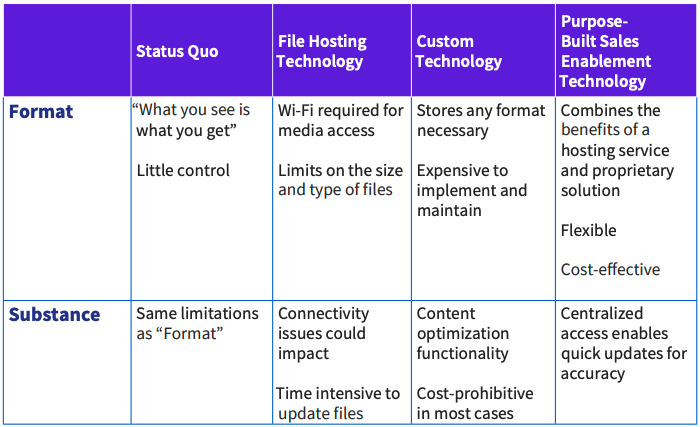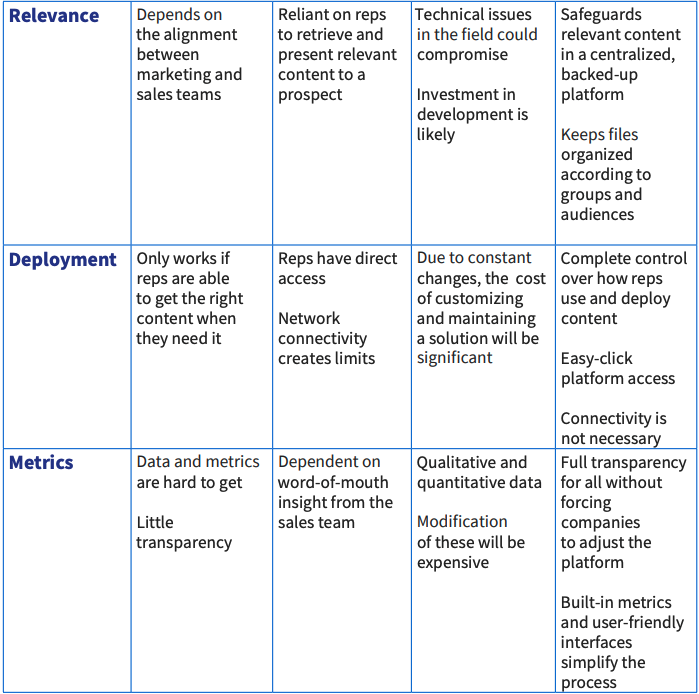Chapter 11
What To Consider When Looking For A Solution
Format
Technology advancements mean a more comprehensive range of content formats are available in the sales field, from standard PDFs and print collateral to dynamic audio and video media.
What to Consider When Choosing Content Formats
- Will it boost engagement during the sales presentation?
- Is it easy for reps to organize, access, and transport?
- What are its storage and security requirements?
One-dimensional presentation tools—such as PowerPoints, PDFs, and print sheets—might articulate the details of a life science solution, but they lack the punch needed to differentiate it in the mind of a specialist.
Rich media formats that include video tutorials, calculators, and forms are a great way for reps to improve engagement during the sales presentation. With dynamic audio and visual cues, prospects are likely to retain at least half the information presented.
Storage and security also play a crucial role in choosing content formats. Print and linear documents are expensive and cumbersome to manage in the field. With more sophisticated content formats, companies must have the technology to store and secure large files—or at least the web development resources to do so. Deploying sophisticated content through mobile is also a challenge.
Substance
The detailed content in a product guide varies from the straightforward text of a data sheet—not to mention that it all has to be positioned and articulated in a way that maintains compliance.
What to Consider When Developing Substantive Content
- Will it make it easier for reps to articulate products?
- Does it meet compliance requirements?
- Does it meet brand standards?
Engaging content not only gives reps an advantage, but also looks more professional. Also, the clearer content is, the easier it is for reps to retain the information and deliver more knowledgeable, informative presentations in the future. With these attributes, newer salespeople have more confidence, and seasoned ones have more context to emphasize important points.”
To minimize the risk of compliance violations and the fines, lawsuits, and damaged company reputations that go along with them, marketers must work closely with their legal departments during the content development process.
Relevance
What matters to one specialist might not matter to the next. Several variables factor into creating relevant content, and sales and marketing need alignment on all of them.
What to Consider When Developing Relevant Content
- Does it align with the reps’ audience?
- Have the marketing and sales teams collaborated during the content development process?
All the customization, branding, and rich media in the world won’t help reps make sales if the content isn’t relevant. Marketing and sales teams need to collaborate in the development process to align content with the audience’s pain points, concerns, and unmet needs.
It can’t be generic because healthcare is complex. Different buyers have different needs. Additionally, it’s a rapidly changing market that has just experienced an accelerated digital transformation and a host of new challenges.
The earlier marketing and sales align themselves on how to position and articulate solutions, the more time they’ll save in the sales process and the better return they’ll get from their content development investment.
Deployment
Content deployment involves the presentation of marketing material and how accessible it is for the sales and marketing teams.
What to Consider When Deploying Content
- Do reps have instant access to content?
- Is the deployment targeted and controlled?
- Can the content be deployed and transferred securely?
Reps need immediate, real-time access to content to make sales with limited selling time. They need to have it at their fingertips and the ability to share it online and offline.
If marketing relies on reps to organize and deploy content in silos with disparate tools, they lose visibility and control over the presentation. Reps can quickly deploy content and pitch solutions in unintended ways that risk compliance violations. Having a centralized means for accessing and deploying content mitigates these risks by giving companies greater control over content usage in the field.
Metrics
Companies can no longer rely on observations and inputs from the rep to enhance the presentation. Defining the right metrics means gaining greater visibility into how content is driving sales results.
What to Consider When Implementing Content Metrics
- How will content effectiveness be measured?
- Has marketing received feedback from the sales team?
- Is there a way to capture quantitative data from the presentation?
Marketers can’t refine and optimize content for the sales presentation without understanding consumption. Therefore, you should define content metrics at the beginning of the development process, and they should align with sales goals.
Qualitative and quantitative metrics can gauge content effectiveness. That’s why sales reps need to provide anecdotal feedback to the marketing team about what they notice during the presentation. This feedback should answer the following questions:
- What content has the best response?
- What content is unused?
- What content is lacking?
In addition, data such as file opens, form submissions, and presentation length gives marketers great insight into optimizing content to drive conversions.




